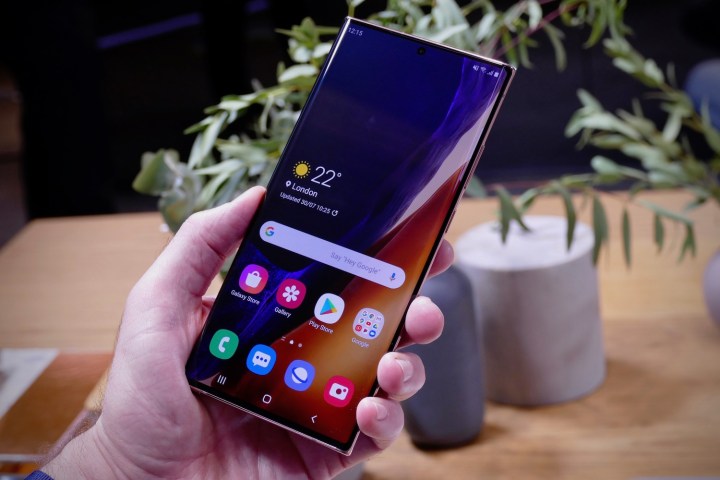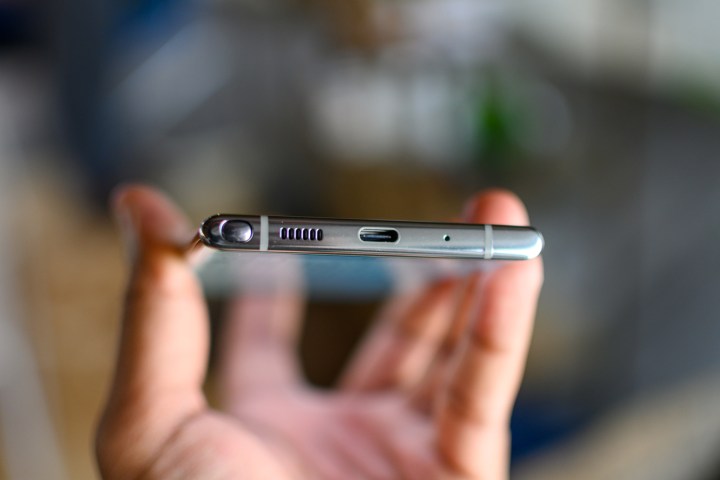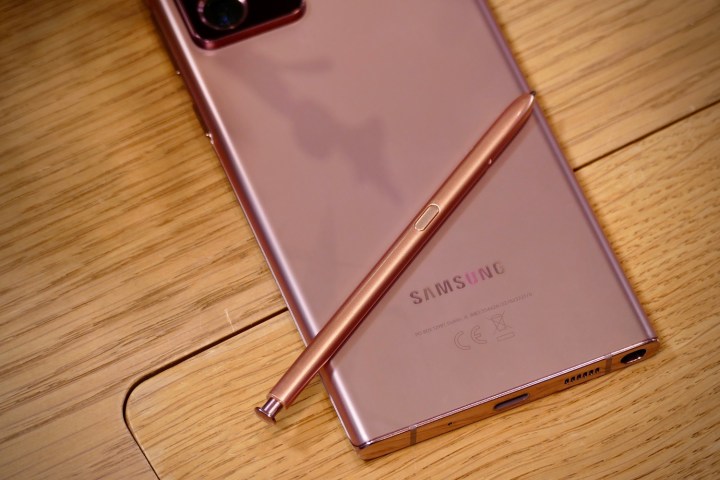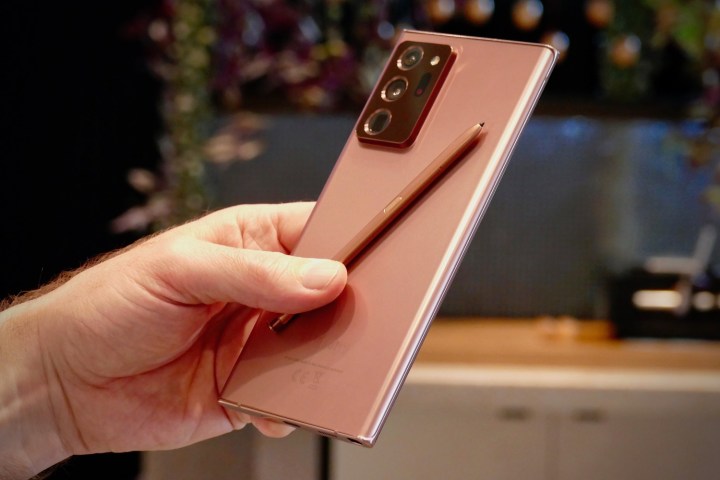Last year’s Samsung Galaxy Note 10 Plus was big, but this year’s Galaxy Note 20 Ultra is even bigger. It’s the direct successor to the Note 10 Plus, offering a larger screen, a more powerful processor, tastier camera specs, and a bigger battery. It certainly looks like it should be a better Android smartphone, but does hype match up to reality? We compare the two mobiles to find out, weighing up the Samsung Galaxy Note 20 Ultra and the Galaxy Note 10 Plus over six categories, to help you to decide which of these two flagships is better for you.
Want to know more about Samsung products? Check out our review on Samsung Galaxy S21.
Specs
| Samsung Galaxy Note 20 Ultra |
Samsung Galaxy Note 10 Plus |
|
| Size | 164.8 x 77.2 x 8.1 mm (6.49 x 3.04 x 0.32 inches) | 162.3 x 77.2 x 7.9 mm (6.39 x 3.04 x 0.31 inches) |
| Weight | 208 grams (7.33 ounces) | 196 grams (6.91 ounces) |
| Screen size | 6.9-inch Dynamic AMOLED 2X | 6.8-inch AMOLED |
| Screen resolution | 3,200 x 1,440 pixels, 20:9 ratio (511 pixels per inch) | 3,040 x 1,440 pixels, 19:9 ratio (498 ppi) |
| Operating system | Android 10, One UI 2.1 | Android 10; One UI 2 |
| Storage | 256GB, 512GB | 256GB, 512GB |
| MicroSD card slot | Yes | Yes |
| Tap-to-pay services | Google Pay, Samsung Pay | Google Pay, Samsung Pay |
| Processor | Exynos 990 (global), Qualcomm Snapdragon 865 Plus (USA) | Exynos 9825 (global), Qualcomm Snapdragon 855 (USA/China) |
| RAM | 12GB | 12GB |
| Camera | 108-megapixel, 12MP telephoto, 12MP ultrawide rear, 10MP front, | 12MP, 12MP telephoto, 16MP ultrawide, 0.3MP time-of-flight rear, 10MP front |
| Video | 8K at 24 fps, 4K at 60 fps, 1080p at 240 fps, 720p at 960 fps, HDR10+ | 4K at 60 fps, 1080p at 240 fps, 720p at 960 fps, HDR10+ |
| Bluetooth version | 5.1 | 5.0 |
| Ports | USB 3.2, USB-C | USB 3.1, USB-C |
| Fingerprint sensor | Yes, in-display | Yes, in-display |
| Water resistance | IP68 | IP68 |
| Battery | 4,500Ah
Fast charging (25W) Qi wireless charging (15W) Reverse wireless charging (9W) |
4,300mAh
Fast charging (45W) Qi wireless charging (15W) Reverse wireless charging (9W) |
| App marketplace | Google Play Store | Google Play Store |
| Network support | All carriers | All carriers |
| Colors | Mystic Bronze, Mystic Black, Mystic White | Aura Glow, Aura White, Aura Black, Aura Blue |
| Prices | $1,299 | $1,099 |
| Buy from | Samsung, AT&T, T-Mobile, Verizon, Amazon, Best Buy, Walmart | Samsung, AT&T, T-Mobile, Verizon, Amazon, Best Buy, Walmart |
| Review score | 4 out of 5 stars | 4.5 out of 5 stars |
Design, display, and durability

Being part of the same series, it’s hardly surprising to find that the Samsung Galaxy Note 20 Ultra and Galaxy Note 10 Plus look very similar. However, if you squint at them carefully, you’ll notice a few subtle differences. The Note 20 Ultra departs ever so slightly from the traditionally angular design of its predecessors (and also the Note 20), featuring fine curves around its edges that give it a slightly more refined appearance. It’s also 2 millimeters taller and 0.2mm thicker, but this difference isn’t really noticeable when you hold either phone (they’re both big).
The Note 20 Ultra also has a fractionally sharper and more vivid screen. It sports a 3,200 x 1,440 resolution, in comparison to 3,040 x 1,440 on the Note 10 Plus. This provides it with 13 more pixels per inch than its predecessor, which isn’t really noticeable. At the same time, the inclusion of a Super AMOLED screen does provide a tangible difference in quality. When coupled with the 120Hz refresh rate, it’s likely to offer a more fluid and vibrant screen experience.
Predictably enough, the Note 20 Ultra and Note 10 Plus both come with IP68 certification. This means they’re resistant to dust and can withstand immersion in shallow water for up to 30 minutes. This puts them on an equal footing, but with slight-yet-detectable differences in the design and display areas, this round is going to the Note 20 Ultra.
Winner: Samsung Galaxy Note 20 Ultra
Performance, battery life, and charging

They may pack equal amounts of RAM and ROM, but the Note 20 Ultra lays claim to a newer processor. It’s equipped with the Snapdragon 865 Plus in the United States (and China), while it runs on Samsung’s own Exynos 990 in the rest of the world. The Note 10 Plus operates on the Snapdragon 855. It’s hardly a slow processor, but the 865 offers a small advantage that could make itself known if you run some of the latest games and apps at the same time.
That’s not to say the Note 10 Plus can’t hold its own. Like the Note 20 Ultra, it offers 12GB of RAM, as well as the option to upgrade from 256GB of internal memory to 512GB. As such, you may never notice that it’s relying on an older processor, given the evenly matched hardware elsewhere.
The battery is where both phones drift apart again. The Note 20 Ultra is fed by a 4,500mAh battery, while the Note 10 Plus depends on a 4,300mAh cell. We found in our review of the Note 20 Ultra that it can last a full day of heavy usage without needing a charge. By contrast, our review of the Note 10 Plus found that it doesn’t last as long as you might expect, struggling to see out an entire day with heavier users.
On the other hand, the Note 10 Plus supports fast charging at 45W, while the Note 20 Ultra supports only 25W. This may provide enough compensation for those who able and willing to recharge often. Both phones support wireless charging at 15W.
This round is another close one. With its slightly faster processor and more enduring battery, we’re giving it to the Note 20 Ultra.
Winner: Samsung Galaxy Note 20 Ultra
Camera

Things may be close when it comes to displays and performance, but it’s clear that Samsung wanted to push the Galaxy Note 20 Ultra over the edge with its camera. It packs a whopping 108-megapixel main camera lens, while the Note 10 Plus offers only a 12MP equivalent. Both phones feature a 12MP telephoto lens, but while the Note 20 Ultra comes with a 12MP ultrawide lens, the Note 10 Plus offers a 16MP version.
Our review of the Note 10 Plus indicated that it had a strong and versatile camera overall, but was sometimes let down a little by closeups on its main wide-angle lens. As for the Note 20 Ultra, it’s even more versatile than its predecessor, and performs very well in the vast majority of situations. It certainly takes better, more detailed photos at 5x and 10x zoom levels.
The Note 20 Ultra lets users shoot video at 8K resolution and at a rate of 24 fps. By contrast, the Note 10 Plus can take you up to a maximum 4K resolution at 60 fps. This isn’t a massive difference, but it could mean that some amateur cinematographers prefer the Note 20 Ultra for its more detailed video capabilities.
Again, this round is another close one. The Note 20 Ultra edges out a win, though, since its use of a 108MP wide lens solves some of the problems that stopped the Note 10 Plus’ camera from being unreservedly excellent.
Winner: Samsung Galaxy Note 20 Ultra
Software and updates

The Galaxy Note 20 Ultra and the Note 10 Plus operate using One UI 2 OS, which is Samsung’s own Android 10 skin. This is a good thing, since One UI 2 is made with larger devices in mind, making it easier for users to navigate their phones and open/use apps.
As for updates, both devices are obviously made by Samsung, which hasn’t always had the best track record in rolling out Android updates. However, they’re both in the same boat here, so this round is another draw.
Winner: Tie
Special features

The Galaxy Note 20 Ultra is a 5G phone as standard, and supports all major 5G bands. Unfortunately, the Note 10 Plus isn’t 5G-compatible as standard, with customers needing to pay an extra $200 for the privilege of using the fastest networks.
The Note 20 Ultra has also been built to stream Xbox games, counting itself as the first smartphone to achieve this feat. It will be optimized to run Xbox titles, with users able to stream around 100 games after subscribing to an Xbox Game Pass at $15 per month. It can also be paired with an Xbox controller, turning it into a kind of mini-console.
Other than that, both phones shape up similarly. They both come with the now-familiar Note-series stylus (the S Pen) and are both tailored more toward the higher end of the smartphone market, at professionals and creatives who want to work (as well as play) on their phones.
Combined with default 5G support and Xbox-streaming capabilities, this round is a decisive win for the Note 20 Ultra.
Winner: Samsung Galaxy Note 20 Ultra
Price and availability
Prices for the Samsung Galaxy Note 20 Ultra start at $1,299. It’s being supported by all major carriers and sold by most major online retailers.
The Note 10 Plus is also supported by all major carriers and also sold by the vast majority of major online retailers. It starts from $1,099, while its 5G model can be had for $1,299.
Overall winner: Samsung Galaxy Note 20 Ultra

There isn’t a massive difference between the phones, but the Samsung Galaxy Note 20 Ultra is certainly the best device of the two. Its subtle design and display upgrades, as well as its new special features, bigger battery, and superior camera, result in a phone that offers more to the average user than its predecessor.
Of course, if you don’t mind going without 5G, then the Samsung Galaxy Note 10 Plus is still a highly recommended phone. It’s at least $200 cheaper than its successor, and while it doesn’t quite pack the same amount of proverbial punch, it’s still a very usable and fun smartphone.



